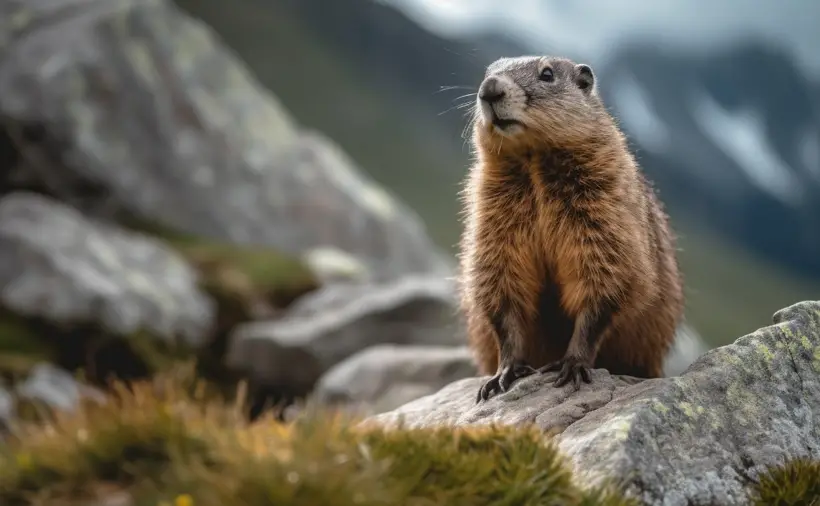How Big is A Marmot Compared to Similar Animals?
Have you ever seen an animal that looks similar to a marmot? Or perhaps you’re planning to join a wildlife conservation program after watching others celebrate Marmot Day. If yes, then you should know how to identify them.
And for this reason, you should know the answer to – how big is a marmot compared to similar animals? Marmots are quite large rodents compared to similar animals. They are usually yellowish-brown in color.
However, they can’t be easily distinguished if you don’t know much about animals, or you can get confused when seeing a marmot of different species. So, let’s learn more about how you can easily distinguish them.
How Big are Marmots?
Marmots normally grow to 68 cm long as an adult, while their weight generally varies from 3 to 10 kg depending on the species.
Usually, they have short bushy tails, around 10 to 25 cm long. However, their fur is thick and long but a bit coarse.

Physical characteristics usually affect the sizes. For example, female marmots are usually 1-2 kg lighter than males. Also, females are 2-3 cm smaller in size.
Their age also affects their size; the younger they are, the smaller they are.
Hibernation also affects size; they usually lose 30% of weight after hibernation.
And in the case of diet, these rodents are omnivorous. They usually take more plant-based food before hibernation. But require more protein after hibernation to gain back their required weight.
15 Marmot Species You Should Know

There are 15 species of marmots in total. They are –
Gray Marmot
These are mainly found in China and regions around middle Asia. Their body size usually varies before and after hibernation.
Gray marmot weighs around 4 to 6.5 kg and can reach up to 8 kg in some cases. Their body length ranges from 60 to 80 cm, including their 13 to 15 cm tail.

Bobak Marmot
Native to central Asia and eastern Europe, Bobak marmots usually weigh around 7 kg and their length varies from 48 to 60 cm.
Alaska Marmot
They’re native to the Alaska region and usually weigh between 3.2 to 3.6 kg on average. Also, their length varies from 56 to 62 cm.
Black-capped Marmot
Native to the far east of Russia, the black-capped type is quite small. They weigh between 1.65 to 5.4 kg, and their length ranges from 39 to 62 cm.
Long-tailed Marmot
Long-tailed marmot lives mainly in central Asia. These large species can weigh between 1.5 – 7.3 kg and reach up to 9 kg. Their long tail is about 16-28 cm long, while their head to the body can vary from 37-80 cm.
Himalayan Marmot
Native to the Himalayas, this one weighs 4 – 9.2 kg, its total length is 45-67 cm, and its tail is 12-15 cm.

Forest-steppe Marmot
They can be found in wooded forest steppes and their head-to-body length ranges from 45-66 cm and body mass ranges from 3 – 8.9 kg.
Alpine Marmot
Native to central and southern Europe, these rodents have a 43-73 cm body-head length with a 13-20 cm tail, while the weight ranges from 1.9 – 8 kg.

Menzbier’s Marmot
These central Asian ones are smaller, weigh between 1.85-5 kg, and their head-body length varies from 34.5-50 cm.
Tarbagan Marmot
Tarbagan marmots are native to China, and their weight varies from 6 – 8 kg, and their length varies from 50-60 cm.
Hoary Marmot
These bulky North American marmots range from 62-82 cm in total length, including a 19-25 cm tail. Their body mass varies from 3.7 to 10 kg.

Yellow-bellied Marmot
These rock chuck common marmots weigh between 1.6-5.2 kg, and they range from 47-68 cm in body and 13-21 cm tail.
Olympic Marmot
Olympic marmots are usually 3.1 to 9.3 kg, and their tail ranges from 18-24 cm with 67-75 cm total length.
Vancouver Island Marmot
Adult Vancouver island marmot weighs from 3-7.5 kg, where the length varies from 65-70 cm.
Groundhogs
Native to North America, groundhogs are a bit heavier. They weigh between 2-6.3 kg, and their length varies from 41 to 68.5 cm, including the 9.5 -18.7 cm long tail.
The differences between marmots and groundhogs are marmots are lighter but can be longer, and native to many countries.
Comparing Marmot Size to Similar Animals

Let’s get to know how marmots are different with our wildlife size comparison.
Marmot vs Rodents
The most common rodents are the squirrels such as ground squirrels, flying squirrels, tree squirrels, and chipmunks. However, most are smaller than the marmot or ground squirrel. Let’s see the marmot size compared to other rodents.
Prairie Dogs
Prairie dogs are usually 30-40 cm in size and have thin small tails. They look so similar to the marmots as they’re considered the closest rodents to them.
You can distinguish them with their tails as they’re hard to differentiate with sizes.

Flying Squirrel
In the case of flying squirrels, they are grayish, and their size is around 20 to 30 cm in length. So, they are so small compared to the marmots.
Tree Squirrel
The size range of tree squirrels is wide. They can be 12-92 cm long and weigh 0.2 to 1.8 kg. They mainly live above the trees, and that’s how the name came.
Marmots live near grounds, so it’s easy to distinguish when you see a similar animal on trees; it’ll be a tree squirrel.
Chipmunks
The chipmunks are even smaller and can be fitted on your palm. Their body length ranges from 8-16 cm, and their tail is 6-14 cm. They’re so tiny that you won’t ever mistake if they’re marmot or not.
Capybara
Capybaras are large rodents where adults weigh from 35 to 65 kg and their body size can be up to 140 cm. Although they are big, they look quite the same to the marmots, specifically the younger ones.
However, they don’t have tails, unlike the marmots, so you can easily distinguish between them.
Marmot vs Other Mammals
Sometimes distinguishing marmots from other mammals can be hard if you’re not good with wildlife. Let’s see how they differ.

Rabbits
Rabbits are smaller than most marmots. Any average house rabbit usually weighs around 3 kg, but the larger breeds can weigh 5 to 7 kg, while the mini breed weighs less than 2 kg.
Also, their tails are so small compared to the marmots, only 5 cm long on average.
Foxes
Foxes are quite large mammals compared to marmots, and they are also easily distinguishable. The usual foxes are red, light brown, or gray in color.
Their average body size is 50 cm, and has very long and fluffy tail that ranges from 45 to 90 cm.
The adult fox usually weighs between 5 to 7 kg. These foxes have quite large ears compared to the marmots, and their legs are also longer.
If you’re interested in marmots, you might be wondering about the difference between marmot and groundhog or if they are endangered. At RodentsFact, we have articles on the difference between marmot and groundhog and are marmots endangered. Our article on difference between marmot and groundhog covers the similarities and differences between these two closely related rodents, while our article on are marmots endangered explores the status and conservation efforts for marmots in the wild. By learning about these aspects of marmots, you can gain a better understanding of their behavior and the threats they face in their natural habitat.Conclusion
So, how big is a marmot compared to similar animals? Usually, depending on their species, region, food habits, age, and gender, their size fluctuates a lot.
But despite these diverse characteristics, they can easily be distinguished between other rodents and mammals if you know the information properly.
We need to understand the wildlife size for emergencies, identifying and properly conserving them. Because if you find a rare breed of marmot with different food habits, and you treat them like other rodents or mammals, they can easily get sick and die.
However, further research is needed to know more about the marmots with the help of wildlife conservation organizations because some of these species can be fatal for humans in one way or another.




